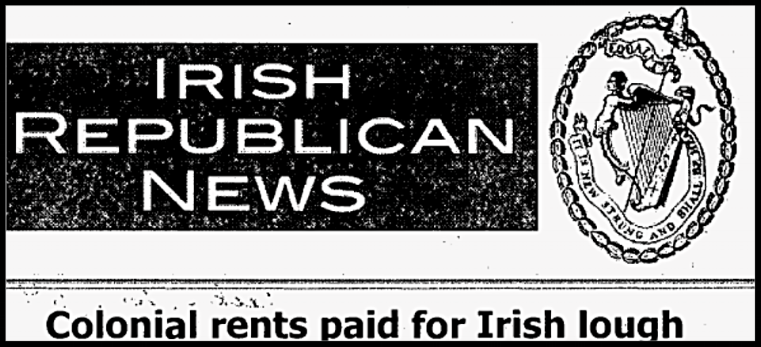The designation was made for the purposes of The Urban Waste-water Treatment Directive which came into force on 21st May 1991.
The identification of the outer limits of Estuaries in Ireland for the UWWTD appeared in a report by the EPA (ROI) dated February 1995. This was done in collaboration with the UKDoE and primarily under UK Regulations. The primary work was done by the DoE with basically the rubber stamp of the EPA.
The UWWTD requires that Member States establish the outer (seaward) limits of estuaries for the purposes of the directive.
Article 2 of the UWWTD directive defines 'estuary' as: the transitional area at the mouth of a river between fresh water ans coastal water.
The (present) line designating the outer limit of the estuary (near the river mouth at Culmore) was determined from 'an assessment of the available salinity data' primarily.
The Humber and Severn Estuaries were subjected to this process and declared Coastal Waters. The two cities of Bristol and Kingston upon Hull successfully brought a judicial review against the UK DoE in January 1996. There must surely be a precedent in this as the court dismissed the case on the grounds that the UK proposals under the UK Regulations were not in the spirit of the EC Directive. This renders the use of these regulations for the Foyle classification as questionable at the very least.
The provisions of the UWWTD will be subsumed into the Water Framework Directive in May of this year so a proper designation is now urgently required to avoid this faulty classification becoming becoming fully ratified.
Discharges into Coastal Waters have less stringent control than into estuarine waters.
The following abstracts from a paper by M. Elliot and D.S. McLusky entitled 'The Need for Definitions in Understanding Estuaries' should help clarify. Please note that Professor Mike Elliot of the Institute of Estuarine & Coastal Studies, University of Hull, is the leading UK authority on this subject. I have the full paper and if you would like to have it please let me know.
In regard
to the UWWTD and definition of estuaries:
As with all such directives, the European States had discretion in implementing the Directive and thus the U.K. and others chose a further definition, that of the presence or absence of High Natural Dispersing Areas (i.e. the sea) which reflected the response to organic inputs. As such, the (then) UK Department of the Environment (DoE) redefined the Severn and Humber estuaries as sea even though in the case of the latter that ‘ sea ’ area stopped at the Humber Bridge situated halfway along the estuary, and the Severn stopped at the Severn Bridge, situated almost at the top of the estuary (Dyer 1996)!
Given the local pressure to reduce sewage inputs, the two major cities involved, Bristol and Kingston-upon-Hull, successfully brought a judicial review against the UK DoE in January 1996 (Pearce, 1996).
In acting for the municipal authorities, the Institute of Estuarine & Coastal Studies at the University of Hull were asked to clarify definitions of estuaries and thus considered biological, chemical, physical and geographic factors.The scientists and environmental law scholars tended towards an ‘ expert-view ’ definition that ‘if it looks like an estuary, smells like an estuary and behaves like an estuary, then there is a good chance that it is an estuary ’!
In implementing the EU Directive, the U.K. through its Urban Waste-water regulations 1994, adopted two alternative definitions of estuaries: an area receiving freshwater inputs where the waters on a depth-averaged basis have a salinity of less than 95% of the adjacent local offshore seawater for 95% of the time; or: an inlet of the sea bounded by a line between such topographical features as define the seaward boundary of the estuary.
The judicial review supported the first of these definitions and took the view that above this threshold it becomes the sea. However, this definition was never tested rigorously as, in the final decision, the court eventually dismissed the case on the grounds that the proposals were not within the spirit of the Directive.
Even within the UK Regulations it is difficult to see how Lough Foyle was classified as Coastal Waters. It is perfectly clear that the relevant topographical features in this case are between Greencastle and Magilligan point, constituting a relatively narrow coastal break and a line between these points defines the seaward boundary of the estuary. As the entire fresh water production of the rivers Foyle, Roe, Faughan and their tributaries have to exit to the sea across this line twice every day, it would be astonishing if the given salinity limits would permit the estuary side of this line to be declared sea. Nevertheless, the Humber/Severn case dismissal at the judicial review is salutary and seems to offer a legal precedent to instruct the relevant departments to put this thing right. The only real surprise is that it is taking such an effort to cause this to happen.
The technical staff in the DoE(NI) and EPA (ROI) who were dealing with this matter are:
DoE(NI): Michael McAliskey
Marine Assessment and Licensing Team
Water Management Unit
Northern Ireland Environment Agency
17 Antrim Rd. Lisburn
BT28 3AL
Tel 02892623162
Mob 07881540041
EPA(ROI): Shane O'Boyle
Regional Inspectorate
McCumiskey House
Richview
Clonskeagh Rd.
Dublin 14
Tel 00353 1 268 0100
⏩Enda Craig is Spokesperson for Community for a Clean Estuary





























